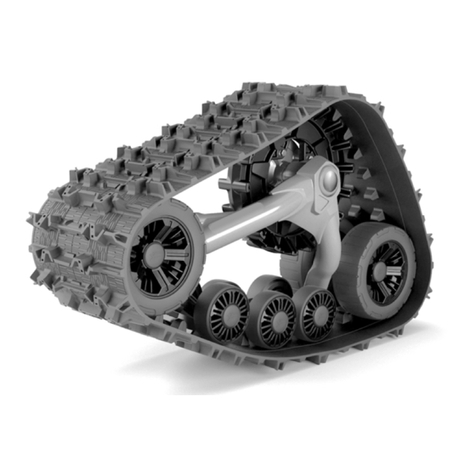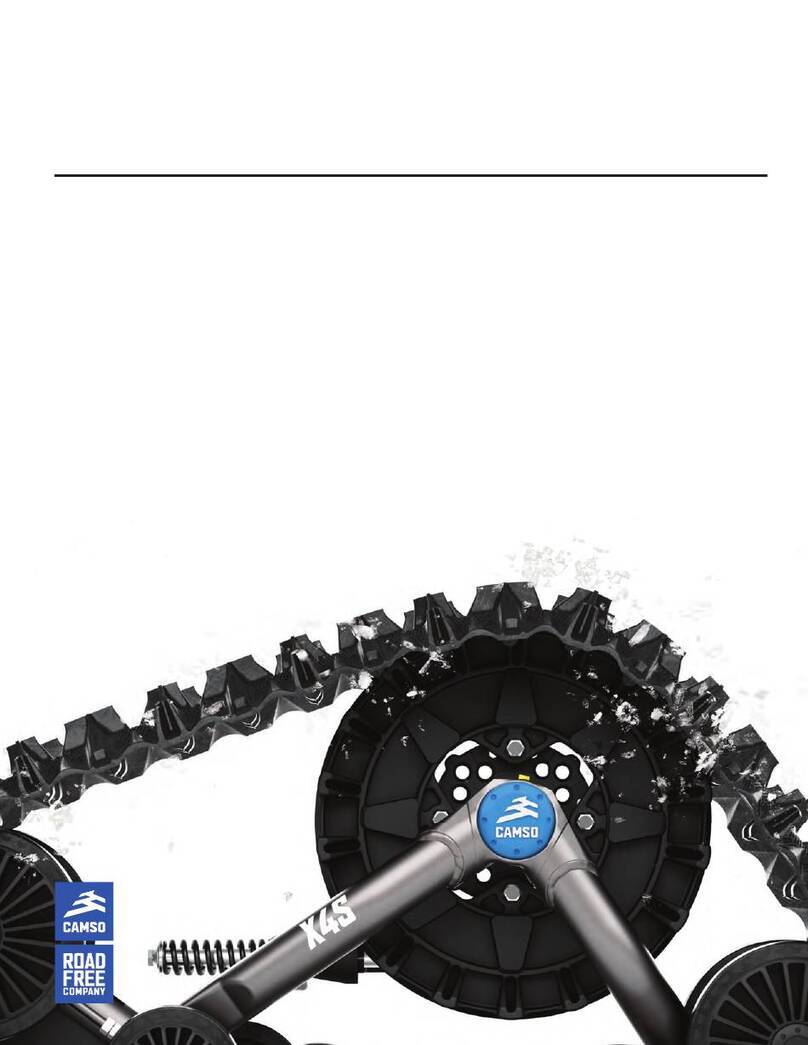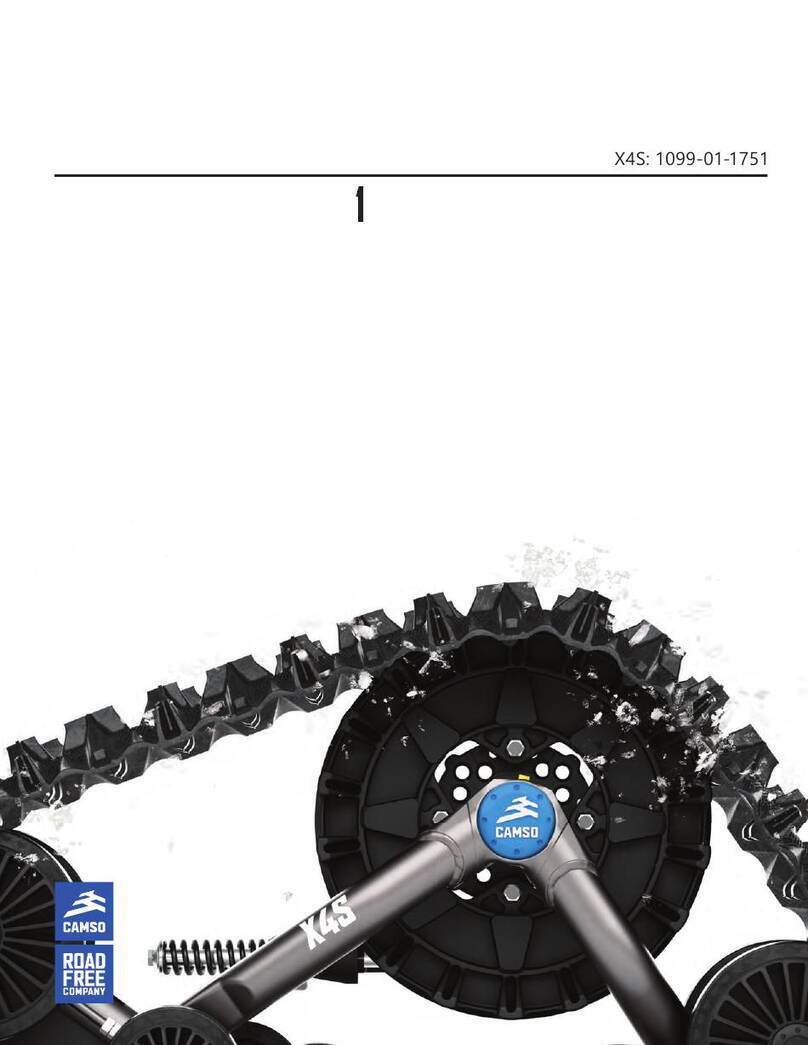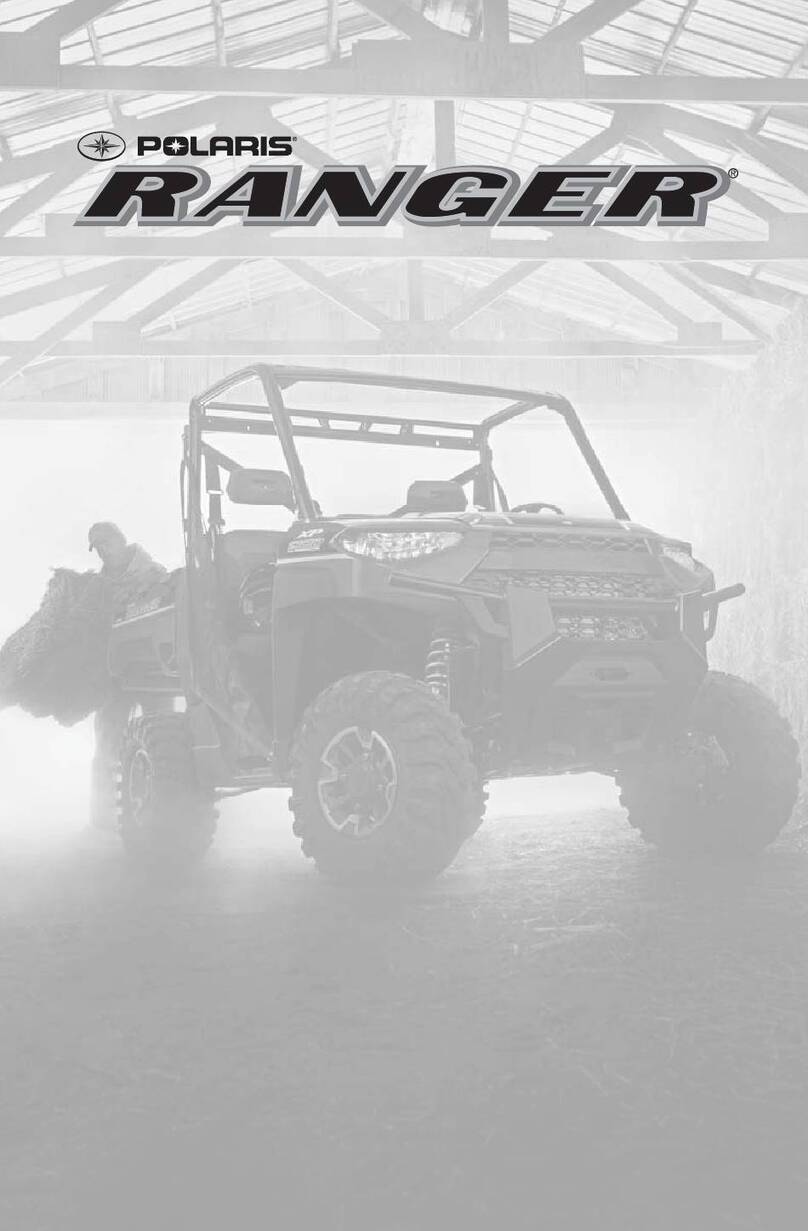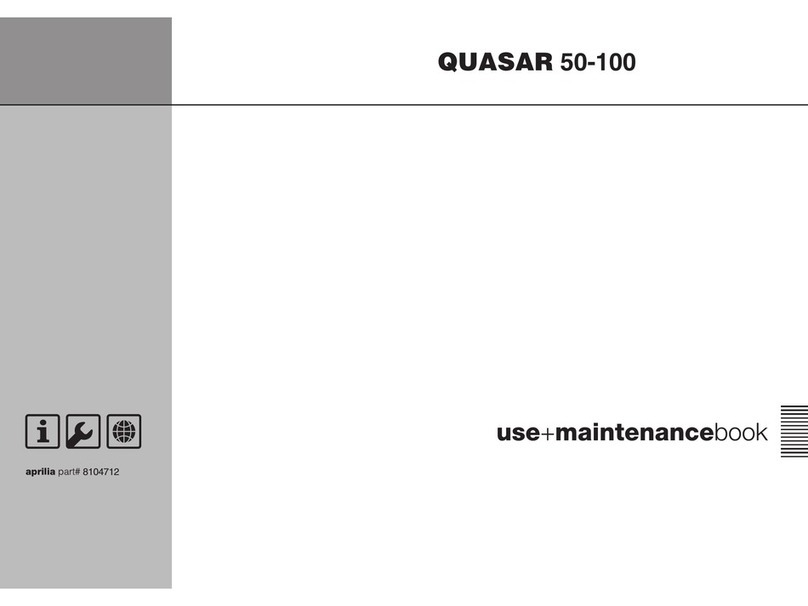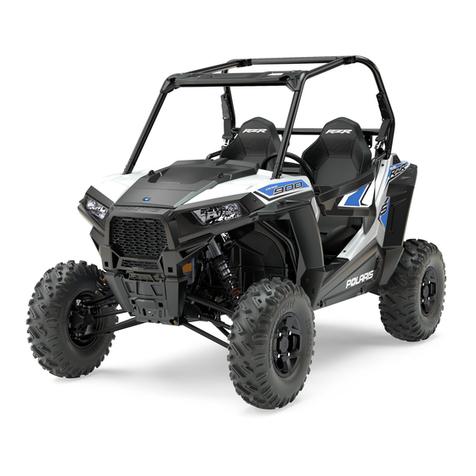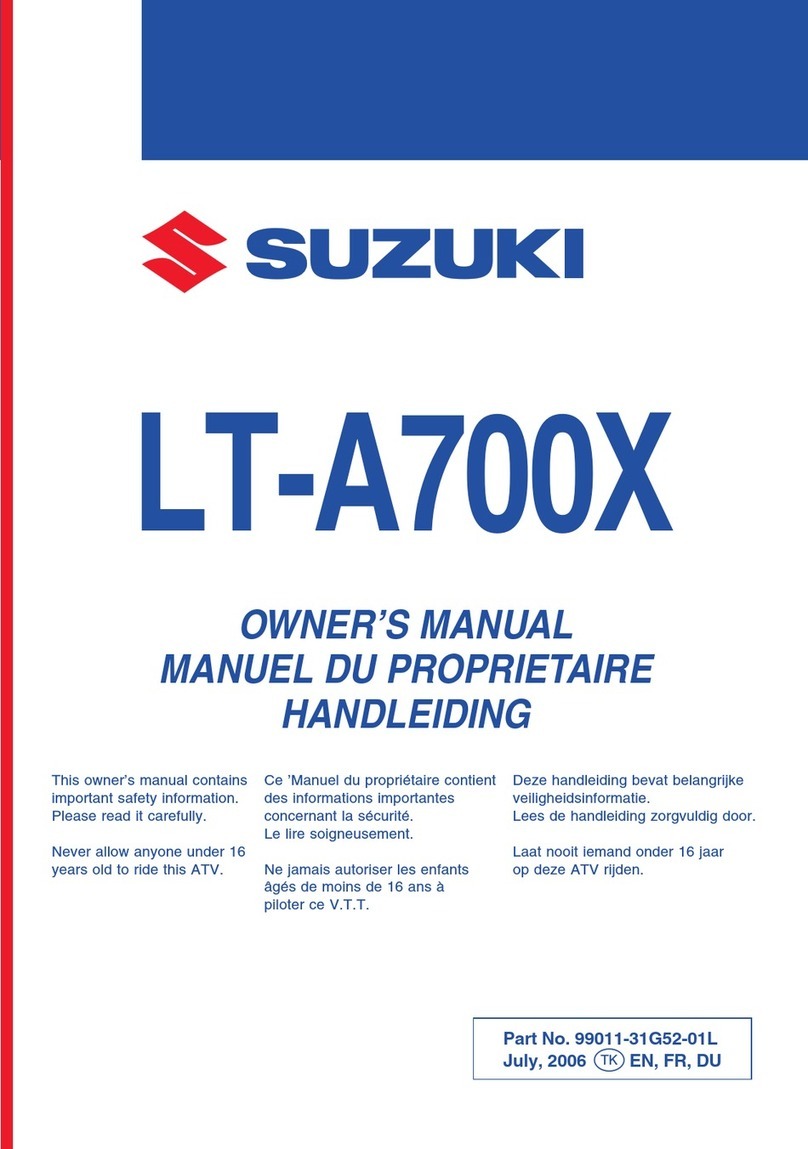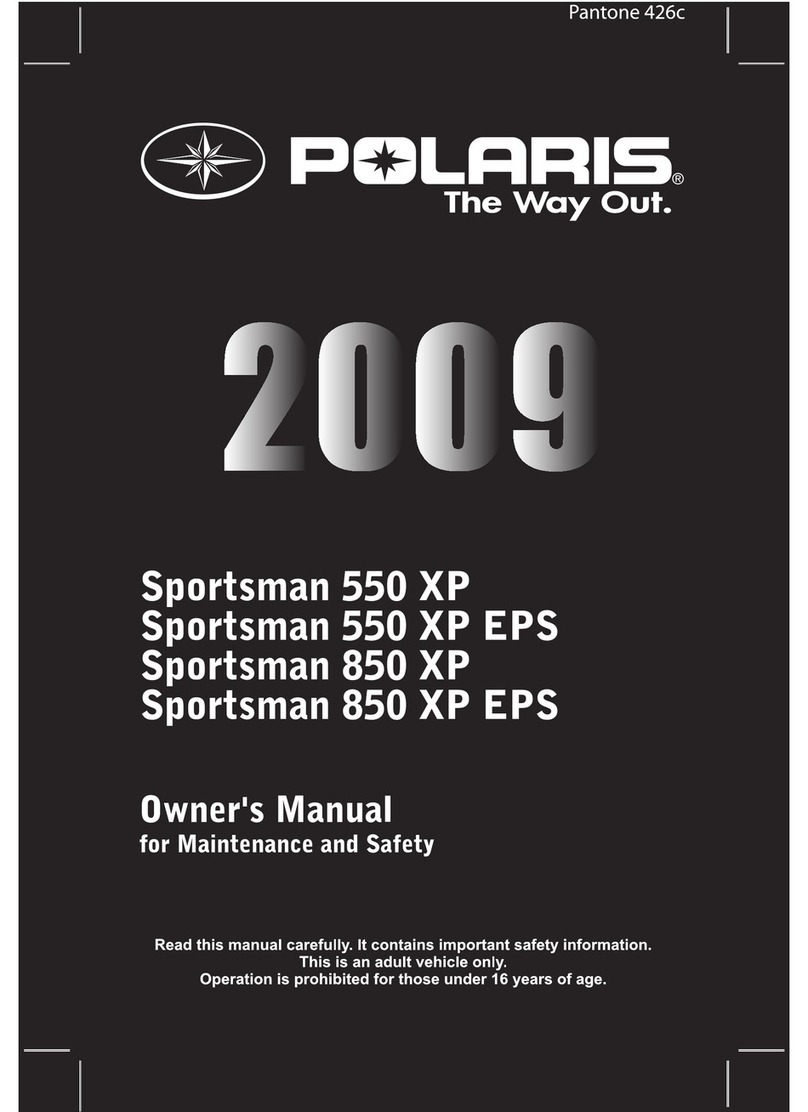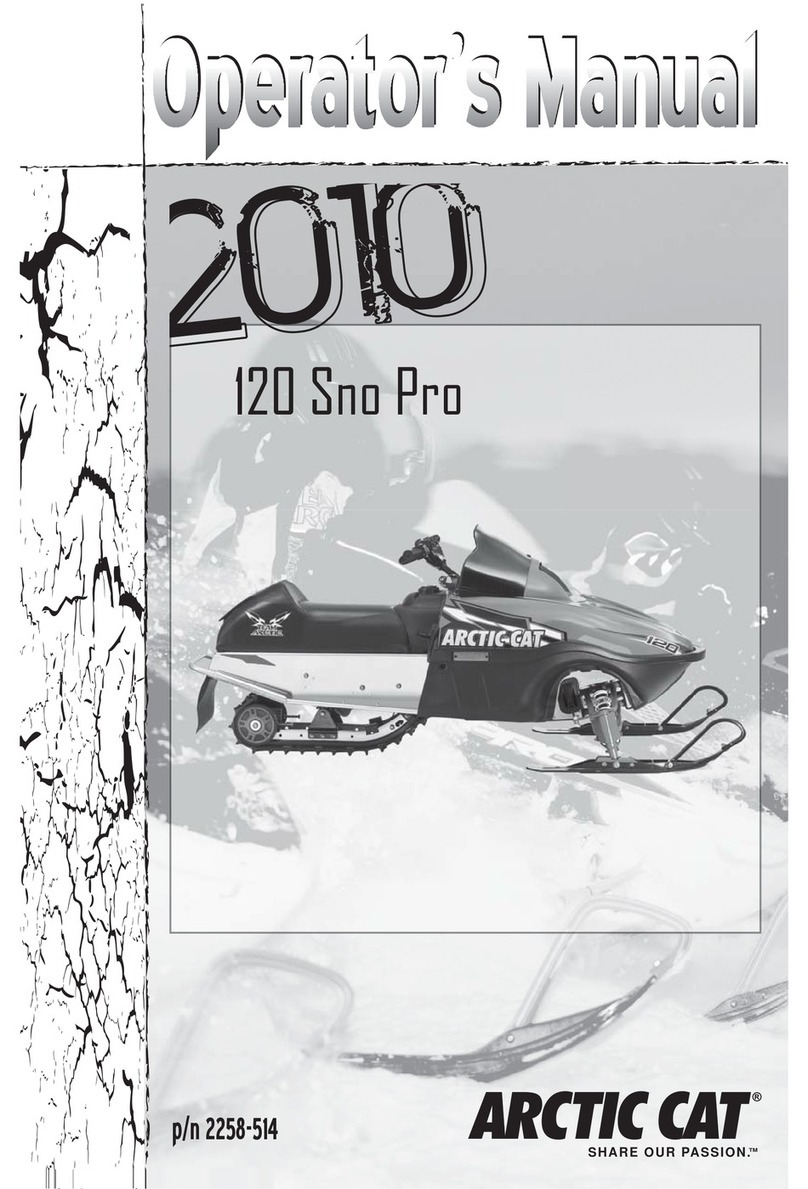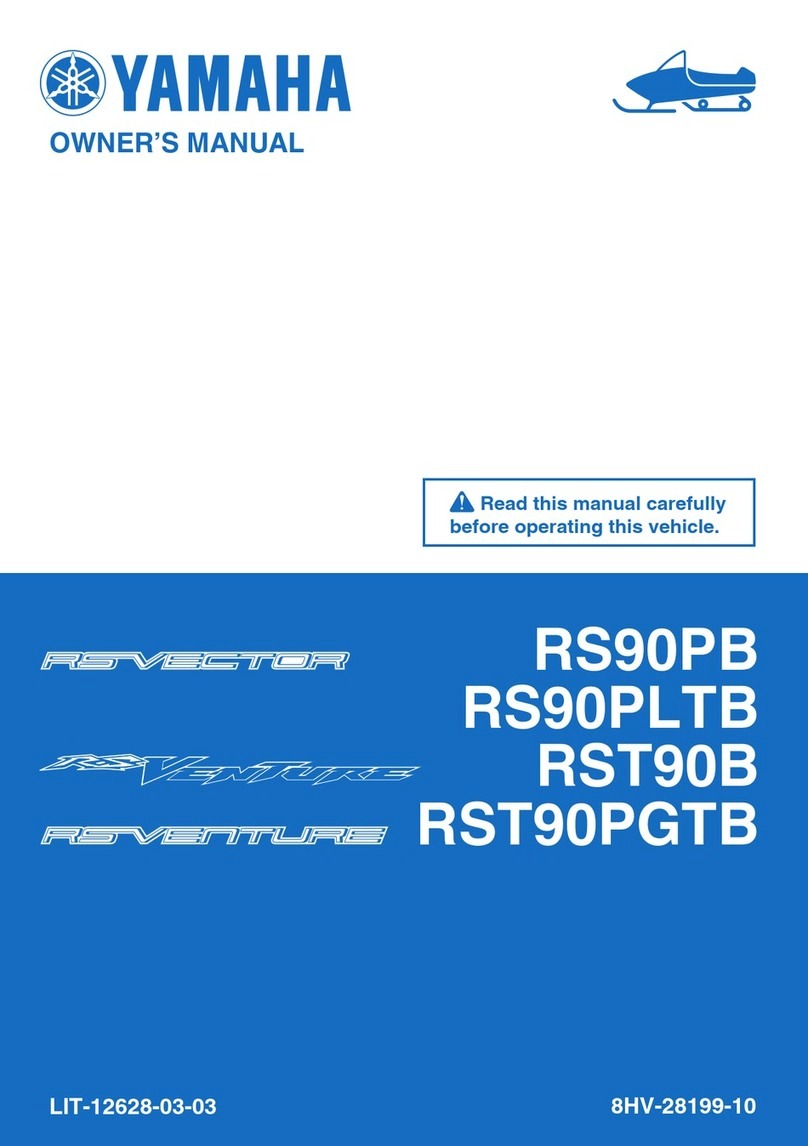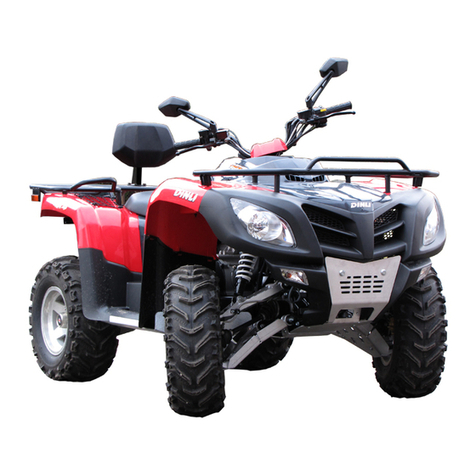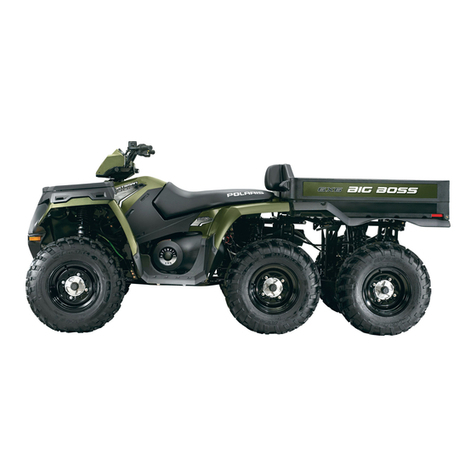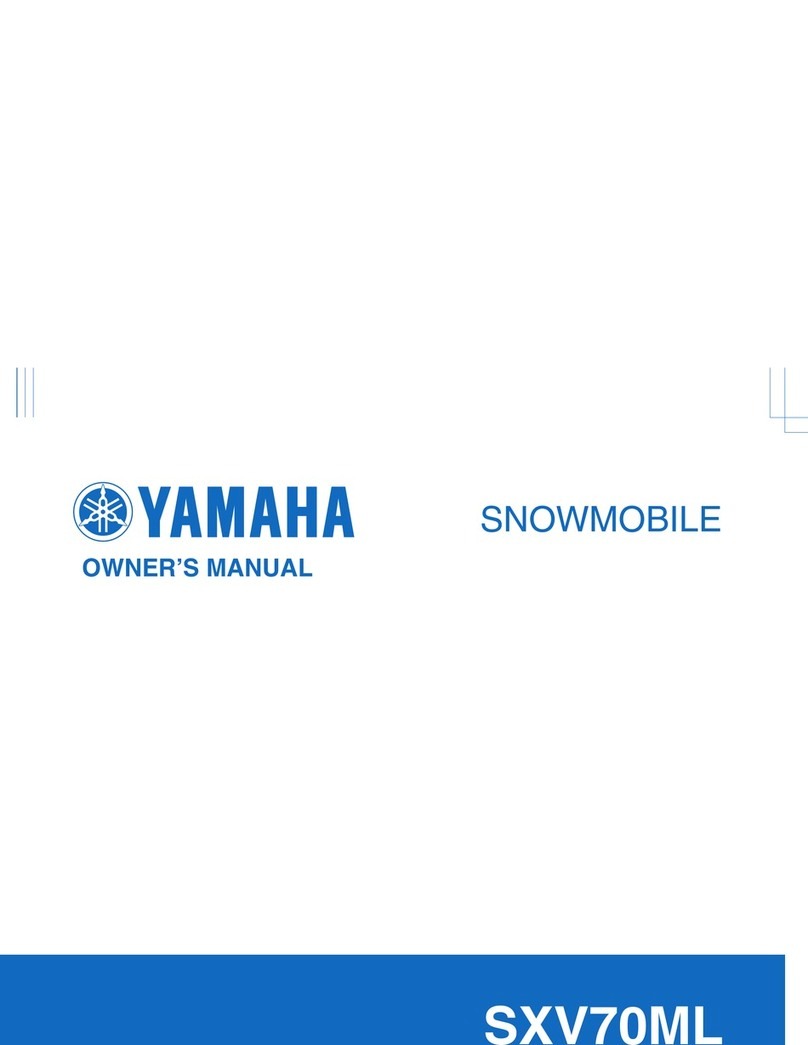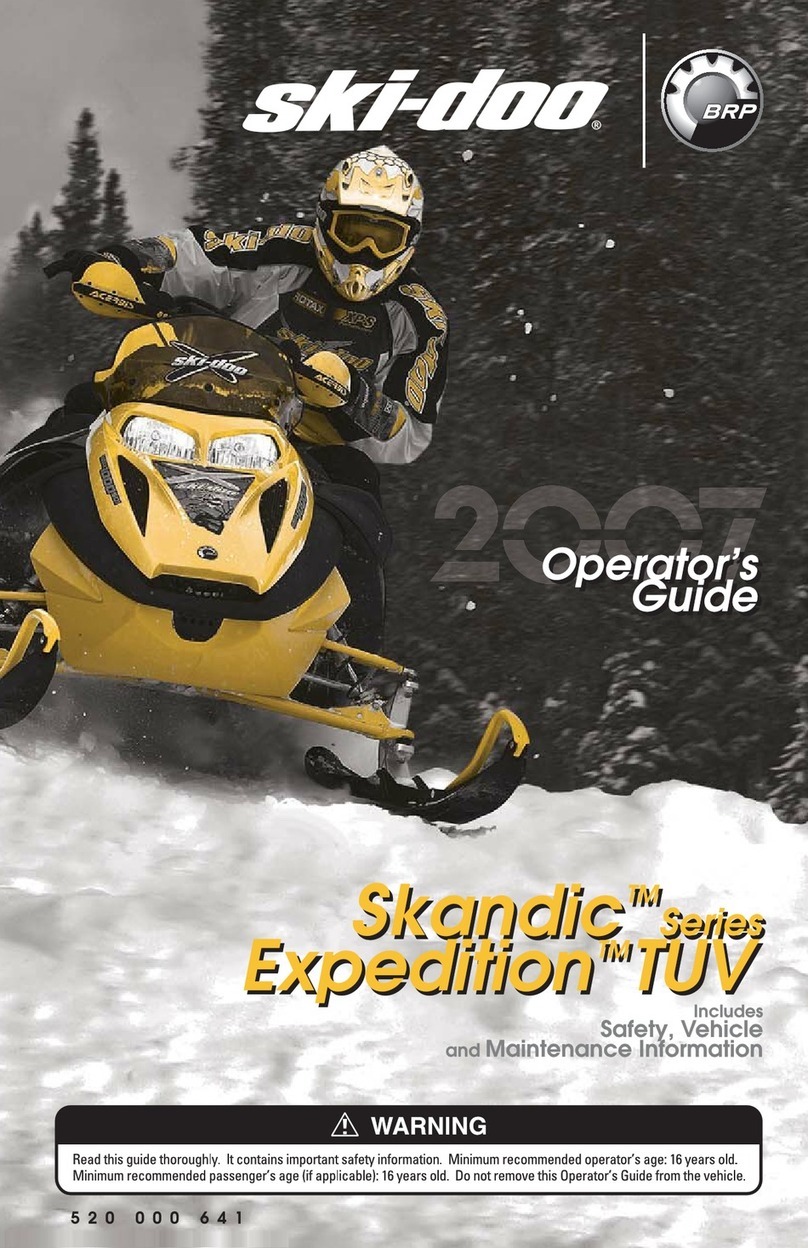CAMSO ATV R4S User manual

CAMSO ATV R4S
FOR ALL-TERRAIN VEHICLES
USER MANUAL 2017
ATV R4S: 1099-01-1317

FormerlyCamoplastSolideal,Camsoisthebestof Camoplastand
Solideal. To keep moving forward while staying true to our
history, we're now Camso, the Road Free Company.
CAUTION: The ATV R4S Track System by Camso, formerly Camoplast Solideal, is first
and foremost designed to provide the best performance in terms of traction and floatation
in conditions of extreme terrain such as deep snow and mud. The Track System is also
designed for side–by-side type vehicles that can ride at a maximum speed of 40 km/h
(about 70 km/h on the speedometer). Exceeding this speed when the terrain conditions
are dry can cause premature wear and or major breakdowns on the Track System. If
breakage occurs due to excessive speed, damage will not be covered under normal
warranty. It is the user's responsibility to abide by these terms of use.
CAUTION: The way in which the ATV R4S Track System by Camso, formerly Camoplast
Solideal, is used is directly linked to the longevity of the system components. Sportive
driving, rapid direction changes and repeated fast turns (more specifically on power
steering vehicles) are not advised. These driving styles increase the risk of derailing and
can cause premature wear and or major breakdowns on the Track System which will not
be covered under normal warranty.
Camso inc.
4162, rue Burrill - Local A
Shawinigan, QC G9N 0C3
CANADA
TECHNICAL SUPPORT
If your dealer or distributor is unable to solve a problem related with the System, you may
contact the Camso support team from Monday to Friday.
E-Mail: [email protected]
Website: www.camso.co
System Serial Number: 6322IU B_______________
Original notice
Translations in other languages available at www.camso.co
WARNING
Please read carefully each part of this document as well as model specific Installation
Guidelines prior to assembling, installing and using the Track System.
®and MC are trademarks of Camso inc.
All rights reserved. ©2017 Camso inc.
Printed in Canada.

TABLE OF CONTENTS
INTRODUCTION . . . . . . . . . . . . . . . . . . . . . . . . . . . . . . . . . . . . . . . . . . . . . . . . . . . . . . . . . . . . . . . . . . . . . . . . . . . . . . . 1
SYMBOLS AND SIGNAL WORDS . . . . . . . . . . . . . . . . . . . . . . . . . . . . . . . . . . . . . . . . . . . . . . . . . . . 1
GENERAL INFORMATION . . . . . . . . . . . . . . . . . . . . . . . . . . . . . . . . . . . . . . . . . . . . . . . . . . . . . . . . . . 1
SERIAL NUMBER LOCATION . . . . . . . . . . . . . . . . . . . . . . . . . . . . . . . . . . . . . . . . . . . . . . . . . . . . . . . 1
SAFETY . . . . . . . . . . . . . . . . . . . . . . . . . . . . . . . . . . . . . . . . . . . . . . . . . . . . . . . . . . . . . . . . . . . . . . . . . . . . . . . . . . . . . 2
OPERATING INSTRUCTIONS . . . . . . . . . . . . . . . . . . . . . . . . . . . . . . . . . . . . . . . . . . . . . . . . . . . . . . . . . . . . . . . . . . . . 4
SPECIFICATIONS . . . . . . . . . . . . . . . . . . . . . . . . . . . . . . . . . . . . . . . . . . . . . . . . . . . . . . . . . . . . . . . . . . . . . . . . . . . . . 8
ADJUSTMENTS . . . . . . . . . . . . . . . . . . . . . . . . . . . . . . . . . . . . . . . . . . . . . . . . . . . . . . . . . . . . . . . . . . . . . . . . . . . . . . . 9
ANGLE OF ATTACK - FRONT TRACK SYSTEMS . . . . . . . . . . . . . . . . . . . . . . . . . . . . . . . . . . . . . . 10
ANGLE OF ATTACK - REAR TRACK SYSTEMS . . . . . . . . . . . . . . . . . . . . . . . . . . . . . . . . . . . . . . . 12
ALIGNMENT . . . . . . . . . . . . . . . . . . . . . . . . . . . . . . . . . . . . . . . . . . . . . . . . . . . . . . . . . . . . . . . . . . . . 12
TRACK TENSION . . . . . . . . . . . . . . . . . . . . . . . . . . . . . . . . . . . . . . . . . . . . . . . . . . . . . . . . . . . . . . . . 14
MAINTENANCE . . . . . . . . . . . . . . . . . . . . . . . . . . . . . . . . . . . . . . . . . . . . . . . . . . . . . . . . . . . . . . . . . . . . . . . . . . . . . . 16
LUBRICATION . . . . . . . . . . . . . . . . . . . . . . . . . . . . . . . . . . . . . . . . . . . . . . . . . . . . . . . . . . . . . . . . . . 19
WEAR . . . . . . . . . . . . . . . . . . . . . . . . . . . . . . . . . . . . . . . . . . . . . . . . . . . . . . . . . . . . . . . . . . . . . . . . . 21
TROUBLESHOOTING . . . . . . . . . . . . . . . . . . . . . . . . . . . . . . . . . . . . . . . . . . . . . . . . . . . . . . . . . . . . . . . . . . . . . . . . . 24
2-YEAR LIMITED WARRANTY . . . . . . . . . . . . . . . . . . . . . . . . . . . . . . . . . . . . . . . . . . . . . . . . . . . . . . . . . . . . . . . . . . 26
’’CE’’ DECLARATION OF CONFORMITY . . . . . . . . . . . . . . . . . . . . . . . . . . . . . . . . . . . . . . . . . . . . . . . . . . . . . . . . . . 27
PATENTS . . . . . . . . . . . . . . . . . . . . . . . . . . . . . . . . . . . . . . . . . . . . . . . . . . . . . . . . . . . . . . . . . . . . . . . . . . . . . . . . . . . 28
PARTS LIST . . . . . . . . . . . . . . . . . . . . . . . . . . . . . . . . . . . . . . . . . . . . . . . . . . . . . . . . . . . . . . . . . . . . . . . . . . . . . . . . . 29
1099-01-1317- VERSION D

1
INTRODUCTION
INTRODUCTION
Thank you for choosing the Camso ATV R4S
Track System, (hereinafter referred to as the
"System"). This system, designed for a more
recreative use, will provide you with all the traction,
performance and durability you require in winter
conditions as well as fall and spring conditions.
This Track System for all-terrain vehicles
(hereinafter referred to as "ATV") is lighter and is
aimed at small engine ATVs; 500 cc or less. It
provides exceptional floatation in snow 60 cm or
less deep, with a ground pressure that is 50% less
than tires. Its strong lightweight steel frame, its
internal sprockets adapted to the vehicle’s
capacity, and its tracks specifically designed for
ATVs, make it the best system on the market in its
category. You will do more with your ATV, at less
cost.
SYMBOLS AND SIGNAL WORDS
This guide uses the following signal words and
symbols to emphasize particular information:
CAUTION: Indicates a potentially hazardous
situation which, if not avoided, may result in
damage to vehicle and Track System components.
NOTE: Indicates supplementary information.
The Prohibition Safety Sign indicates an
action NOT to be taken in order to avoid a
hazard.
The Mandatory Action Sign indicates an
action that NEEDS to be taken to avoid a
hazard.
GENERAL INFORMATION
• All figures, information or photos presented in
this document are up to date at the time of
publication. However, they may change without
notice.
• Read and follow indications of the ATV user
manual and installation guidelines carefully.
Their contents remains applicable after
installation of the System.
• This document should be read by every person
who drives the ATV equipped with the System.
• This document is an integral part of the System.
Pass it along to any new System owner.
• Consult the legal authorities of the area where
you drive your ATV equipped with the System
before usage to ensure that you respect all
applicable laws and regulations.
• ATV Track Systems are designed to reduce
ground pressure and increase vehicle traction.
However, during normal operating conditions,
vehicle speed should be reduced compared to a
wheeled vehicle.
SERIAL NUMBER LOCATION
The following figures show the location of the serial
numbers on the Track System frame (Figure 1) and
rubber track (Figure 2).
Figure 1
Figure 2
WARNING
Indicates a potentially hazardous situation which, if
not avoided, could result in death or serious injury.

2
SAFETY
SAFETY
GENERAL WARNING
You will find on each Track System frame the
general warning sticker (1) shown in the
illustrations below. Read and understand the
sticker carefully before using the Track System. It
contains important information about safety and
proper operation of the Track System.
CAUTION: Do not remove the warning sticker from
the frame. If a sticker is damaged, have it replaced
by an authorized Camso dealer.
User Manual
- Users must read the
User Manual before attempting to
operate a vehicle equipped with a
Track System.
If the Track System is sold or in any
way transferred to a new user, the
User Manual must also be
transferred to the new user.
Moving Parts - Hands or fingers
caught between moving parts of
the equipment present a danger to
life or limb. Turn motor off before
servicing the Track System.
Maintenance Schedule
- Follow
instructions contained in the
Maintenance Schedule section of
the User Manual to ensure safe and
long–lasting operation of the Track
System.
POSITION PICTOGRAM STICKERS
These labels indicate the position of each Track
System unit: front left, front right, rear left and rear
right. They are located on the top of each frame.
Front left Front right
Rear left Rear right

3
SAFETY
USER NOTICE AND DISCLAIMER
The Camso ATV R4S System was initially
designed to be used in winter conditions and was
then adapted to be used in fall and spring
conditions.
This document holds important information
regarding driving an ATV equipped with the
Camso ATV R4S System by Camso. It is
mandatory that every user takes the time to
carefully read, understand and then consult this
reference manual and user guide as well as the
ATV owner's manual as needed. When purchasing
either a new or used Track System, the user must
obtain all documentation related to the System,
including manuals and guides related to the ATV
on which the System is installed.If need be,
contact the Camso products dealer nearest to you
to obtain any additional information. You may also
consult the Camso Web site at www.camso.co
and contact our technical support by email at
enduser[email protected].
Camso believes that there are certain risks related
to the installation and use of the System. Our
experience shows that the System is safe.
However, the user must be aware of the risks
related with driving an ATV with the particularities
of this type of System. The ATV driver must, at all
times, respect all applicable laws and regulations,
the indications of the System manufacturer and
the indications from the vehicle manufacturer fixed
by law, namely when age restrictions exist and
ATV base equipment is required (headlights,
flashers and brake lights, rearview mirror, etc.).
The user must always wear adequate safety
equipment, such as a helmet, safety glasses (or
visor), protective clothing, boots and gloves. It is
understood that driving while impaired or
intoxicated presents a danger for the ATV user
and others and is against the law.
The System consists of many moving parts,
including transmission wheels. If an object lodges
itself or becomes jammed into the System and
blocks the track, it is mandatory to stop the engine
and the vehicle and apply the security brake
before removing said object. By avoiding to do so,
the user exposes himself to sudden movement of
the ATV or to breakage of a part or component
coming from the System, which could cause
severe injuries. It is also very important to wear full
length clothing and always avoid hanging or
stringy accessories.
Driving an ATV equipped with such a System
requires particular precautions and a knowledge of
proper driving techniques of such vehicles. An
evaluation by the user of the conditions and terrain
(state of the ground, grade of hill, density of snow,
etc.) is equally essential.
An ATV equipped with a System cannot compete
and/or be used to perform stunts, acrobatics or
other exploits, as these could result in loss of
control or severe injuries.
Insufficient knowledge of an ATV during down hill
riding, climbs and crossing of obstacles and turns
can result in tipping or roll over, and can cause
severe injuries.
Carrying a passenger, a load or attaching a tow can
cause the ATV to be less stable, and affectability.
Unless otherwise prescribed by law and by the ATV
manufacturer, you must not carry a passenger,
loads or tow any objects.
The installation of a System:
• Increases ground clearance.
• Changes the center of gravity.
• Increases the ATV width and weight.
• Reduces ground pressure.
These parameters will effectively change driving
characteristics of an ATV equipped with the
System.
Consequently, it is highly recommended that the
user adapt his driving style to the new
characteristics mentioned above. The driver
must always use caution when he crosses
obstacles, circulates through narrow paths, meets
vehicles coming in the opposing direction, etc.
As it was designed, the System will considerably
reduce the ATV top speed and can falsify the
speedometer. Generally, the System transmission
wheel diameter is less than that of the tire.
Therefore, the vehicle speed will be less than that
actually displayed. Whether the ATV is equipped or
not with the System, users must always adapt the
speed to actual driving conditions. Users must
never exceed speed limits or drive faster than their
capacities allow. Excessive speed remains one of
the main causes of severe accidents on ATV.
Camso is proud to offer ATV conversion kits within
its wide range of products. ATV Track Systems are
not only reliable, but safe. However, there are risks
inherent to driving an ATV equipped with the
System. It is therefore very important that a driver
familiarize himself with proper driving techniques of
an ATV equipped with a System, and that he adapt
his driving to his level of experience and continually
evaluate operating conditions and terrain to safely
and efficiently make the best of the Camso ATV
Track Systems.

4
OPERATING INSTRUCTIONS
OPERATING INSTRUCTIONS
HINTS AND TIPS
• Before leaving for an excursion, make sure to
bring with you the following: 13 mm, 15 mm, 16
mm, 17 mm, and 19 mm wrenches and sockets,
long-nose locking pliers, a ratchet wrench with 2
in. extension - 3/8 in. drive, an axe, a shovel, a
tow cable, a lifting jack and an adjustable
wrench.
• Generally, the slower you go, the better the
traction will be.
• For riding on excursions on unknown or remote
terrain, make sure you have a cellular phone or
satellite phone, a first aid kit and spare parts in
your possession.
• When driving off trails, always be cautious to the
presence of hidden obstacles.
• When driving in deep snow, do not intentionally
spin the track (tracks keep on turning while the
vehicle does not move).This could cause the
vehicle to get stuck.
BREAK-IN PERIOD
CAUTION: A break-in period is necessary to allow
the components of the system to settle and adjust
themselves to each other.
During the break-in period (4 hours or 80
kilometers), follow these recommendations:
CAUTION: Avoid running under dry and clean
conditions. (For example: asphalt, hay or straw
field, etc). Start sharp turns at very low speed: (10
km/h maximum real speed).
• A GOOD break-in period must be done in a
lubricated environment such as water, mud,
snow, soft soil, sand, dust, etc.
• A BAD break-in period can generate smoke,
odors of burned rubber as well as plastic deposits
on the sprocket and/or the frame.
CAUTION: Non-compliance with the usage
recommendations can lead to a warranty claim
refusal.
PRE-USE VERIFICATION
CAUTION: Before each ride make sure that the
System’s wheels and moving parts are free and that
they are not frozen or stuck on the frame.
CAUTION: It is the rider’s responsibility to verify that
the air intake of the vehicle is well adapted to
weather conditions and is not blocked by snow
accumulation.
JUMPING
INSTALLATION
1ST HOUR - 15 km/h*
VERIFICATION
2ND HOUR - 25 km/h*
3RD HOUR - 35 km/h*
VERIFICATION
* Maximum Real Speed
VISUALINSPECTION XXXX
TRACK TENSION X X X
ANGLE OF ATTACK X X
ALIGNMENT X X
BOLT TORQUE -
Anchor Brackets
X
* Maximum Real Speed
WARNING
Driving a vehicle equipped with Track Systems is
different from driving a vehicle on wheels. It is
strongly recommended that the safety guidelines
provided below are followed to prevent any
accident and/or serious malfunction that could
affect the occupants, the vehicle or the Track
Systems.
WARNING
Jumping with vehicles equipped with Track
Systems is not recommended. These Systems
were not designed to carry out this type of
operation. An ATV equipped with the System must
never be used for the following activities: races,
rallies, jumps, stunts, acrobatics or any other
extreme applications.

5
OPERATING INSTRUCTIONS
STEEP DESCENTS
CAUTION: It is not advisable to change direction
during steep descents. This can lead to a serious
malfunction of the ATV’s steering system and Track
Systems.
CAUTION: During a steep descent, it is advisable to
keep the handlebars straight and to begin turning
when the ATV is on flat ground, thus avoiding
subjecting the vehicle components and the System
to any high stress.
CAUTION: Reduce your speed at all times; Track
Systems installed on a vehicle do not have the same
absorption capacity as tires.
DESCENDING AND BEING STUCK IN
REVERSE
CAUTION: If the rear Track Systems get stuck in the
snow, avoid moving or towing the vehicle in reverse
to ease it from its position, as this could lead to a
malfunction of the Systems. If possible, move it in
the forward direction to free it from the snow.
CAUTION: It is advisable to remove the snow from
the top of the rear Track Systems and to compact it
behind the Systems, using your feet, to dislodge the
track. Shoveling remains the best alternative in this
situation.
CAUTION: Always operate in 4x4 mode, this
significantly reduces possibility of derailing in any
conditions.
WARNING
Allow for a greater braking distance and
periodically apply the brakes while driving to
prevent ice buildup on brake components.
WARNING
Adapt your driving style to surrounding conditions
(weather, traffic, etc.) and your driving abilities.

6
OPERATING INSTRUCTIONS
DRIVING OVER AN OBSTACLE TALLER
THAN 30 cm [12 in]
CAUTION: It is not advisable to attempt to drive
over an obstacle taller than 30 cm [12 in], such as a
tree trunk, stump or big rock.
CAUTION: If the situation occurs, insert a log or a
rock to lower the height of the obstacle and
facilitate driving over the obstacle.
CAUTION: In loaded / working mode (100 kg and
over), reduce significantly your speed and be extra
careful on rough terrain.
CAUTION: Never exceed vehicle cargo and tow
capacity specified by your vehicle manufacturer on
any type of terrain.
DRIVING OVER A STEEP RIDGE
CAUTION: It is not advisable to attempt to drive over
an obstacle, such as a tree trunk, big rock or steep
ridge that could lodge itself between the front and
the rear Track Systems and immobilize the vehicle.
The best option remains to bypass this type of
obstacle.
DRIVING OVER AN OBSTACLE
WARNING
The driver must remain vigilant and cautious at all
times. Snow and mud can hide dangerous
obstacles.
WARNING
Always follow the ATV manufacturer's safety rules
and recommendations regarding, for example
passengers transportation, maximum loads, etc.
WARNING
When travelling in groups, people following
vehicles equipped with Track Systems should by
warned, as tracks can propel dangerous objects.
Be especially cautious on “rocky” trails.

7
OPERATING INSTRUCTIONS
LOCATION OF TOWING CABLE
CAUTION: If your vehicle must be towed out of the
snow, do not secure the towing cable on the Track
Systems.
CAUTION: The towing cable must be attached to the
vehicle’s frame.
TOWING A VEHICLE OUT OF THE SNOW
CAUTION: If your vehicle must be towed out of the
snow, never tow it in the direction in which you were
riding when the vehicle got stuck.
CAUTION: Tow the vehicle in the direction of the
tracks it left before getting stuck.
CAUTION: It is the driver’s responsibility to follow
the recommended scheduled maintenance
described in this manual.
TRACK SYSTEMS OPERATING IN
WATER AND MUD
CAUTION: If Track Systems are used in wet
conditions, submerged in water and/or mud, it is
important to consult the Track Systems’
maintenance chart and to observe the maintenance
intervals indicated in this manual related to
commercial, industrial and abrasive conditions use.

8
SPECIFICATIONS
SPECIFICATIONS
TORQUE SPECIFICATIONS
Refer to the exploded views at the end of the
Manual to obtain torque specifications applied to
bolts at important points on the Track System.
NOTE: Use a thread locker (Loctite 263 type or its
equivalent) at indicated places in the exploded
views of the system.
STORAGE
CAUTION: Contaminants can alter and corrode the
moving parts of Track Systems during storage. It is
strongly recommended to perform the prescribed
maintenance before storing the Track Systems.
Store the System by laying down each frame on its
side, away from direct sunlight. Figure 3.
Figure 3
NOTE: Before storing the System, pour 5 cc of oil under
wheel caps to help prevent corrosion.
OFFSETS ON VEHICLE
Installation of a Track System on a vehicle creates
offsets in length, height and width. The offsets are
illustrated in the figure below and their dimensions
are specified in the accompanying table.
SPEEDOMETER AND TRIP METER
READINGS
Our Track System affects the Speedometer and Trip
meter readings by approximately 35% depending on
the ratio between sprocket and tire size.
DIMENSION GRADE N•m lb-ft
M6-1.0 GR 8.8 10 N•m 7 lb-ft
M6-1.0 GR 10.9 16 N•m 12 lb-ft
M8-1.25 GR 8.8 25 N•m 18 lb-ft
M8-1.25 GR 10.9 33 N•m 24 lb-ft
M10-1.5 GR 8.8 50 N•m 37 lb-ft
M10-1.5 GR 10.9 70 N•m 52 lb-ft
M12-1.75 GR 8.8 90 N•m 66 lb-ft
M12-1.75 GR 10.9 125 N•m 92 lb-ft
WARNING
Overtightening bolts may damage parts and safety
features may be affected.
)5217 LQPP
5($5 LQPP
32/$5,6 LQPP
27+(502'(/6 LQPP
LQPP
2))6(7
/(1*7+
25,*,1$/7,5(LQ
2))6(7
+(,*+7
2))6(7
,'7+

9
ADJUSTMENTS
ADJUSTMENTS
CAUTION: After the first use of the vehicle, the
adjustment settings (track tension, alignment and
angle of attack) on each Track System must be re-
verified. Incorrect adjustments can decrease the
performance of the System and produce
premature wear on certain components.
NOTE: To make the following adjustments, position
the vehicle on a flat and level surface.
ANGLE OF ATTACK - FRONT SYSTEMS
To obtain the correct angle of attack on front
Track Systems, perform the following:
• Orient the steering wheel and Track Systems
straight ahead
• Temporarily apply pressure to the front of the
track to make stay flat on the ground
• Stabilizing arm (
1
) must be attached to front
anchor bracket (
2
) mounted on vehicle. Figure 4.
Figure 4
• A Bubble Level (1) is attached to the inside of
the front frames. A perfectly centered bubble is
needed to adjust the angle of attack correctly.
See Figure 5.
.
Figure 5
NOTE: Before each measurement, temporarily apply
light pressure to the front of the track to make
sure that it stays flat on the ground.
• Loosen jam nut (1). Adjust length of rod end (2)
by rotating the steering limiter support plate on
(3) the stabilizing arm. Use a 30 mm [1 3/16 in]
wrench to rotate support plate to obtain a
perfectly centered bubble in the level. Refer to
Figure 6.
NOTE: The stabilizing arms on front Track Systems
incorporate a steering limiter support plate (3)
which is bent. This plate should be positioned
inwards, towards the vehicle.
Figure 6
• When angle of attack is correctly set, tighten
the jam nut (1) back against the stabilizing arm
to 40 N•m [30lb•ft] of torque. See Figure 7.
CAUTION: Follow the recommended torque when
tightening the jam nut. Overtightening the nut
might damage the rod end.
Figure 7
• Once the centered bubble in the level indicates
that the angle of attack is correct, double-check
the setting by validating the distance from the
top of the back tires to the ground. Figure 8.

10
ADJUSTMENTS
• Position a flat bar on top of the rear wheels of
the front Track System and measure from the
ground up to the flat bar as shown on Figure 8.
Figure 8
NOTE: Once adjustment of the angle of attack on the
front systems is completed, verify once again
to confirm the adjustment.
BASIC TUNING (Front Track Systems)
• An adjustment of more than 254 mm [10 in],
measured with the flat bar, provides easier
steering but produces a wobbling effect at high
speed.
• An adjustment of less than 254 mm [10 in],
measured with the flat bar, results in harder
steering and more stability at high speed.
ANGLE OF ATTACK - REAR SYSTEMS
To obtain the correct angle of attack on rear Track
Systems, perform the following:
RIGID AXLE OR TRAILING ARM SUSPENSION
CAUTION: Some vehicles require a particular
adjustment. Refer to the Installation Guidelines
specific to your vehicle model to confirm the
adjustment.
• Stabilizing arm (1) must be attached to Track
System and to rear anchor bracket (2) installed
on vehicle. See Figure 9.
Figure 9
• Loosen the nut (3) compressing the spring of
the stabilizing rod. See Figure 10.
Figure 10
NOTE: Use the narrow part of the adjusting template
provided with the stabilizing arm to make the
adjustment.
• Set the nut (4) to obtain a distance of 10 mm
between nut and stabilizing arm guide as
shown on Figure 11.
Figure 11
• Turn nut (3) until it comes in contact with the
spring, then compress the spring by turning the
nut 1 1/2 turns. See Figure 12.

11
ADJUSTMENTS
Figure 12
•IMPORTANT: Double-check the 10 mm
minimum distance between nut and stabilizing
arm guide. Re–adjust as needed. Figure 13.
NOTE: Use the provided template to double-check the
adjustment.
Figure 13
INDEPENDENT SUSPENSION (IS)
• Stabilizing arm (
1
) must be attached to rear
anchor bracket (
2
) installed on vehicle. Figure 14.
NOTE: Actual Rear Anchor bracket (
2
) mounted on
vehicle may differ from the one in the illustration.
Figure 14
• Turn stabilizing arm nut to adjust length of rod end
(
1
) and get rubber cone (
2
) to apply light pressure
on anti–rotation retainer (
3
). Figure 15.
Figure 15
• Re-tighten jam nut (
1
) to 40 N•m [30 lb-ft] of
torque when adjustment is complete. Figure 16.
Figure 16
CAUTION: Tighten the jam nut to the recommended
torque specification. Overtightening the nut might
damage the rod end.
NOTE: Once adjustment of the angle of attack on rear
systems is complete, verify once again to
confirm the adjustment setting.
BASIC TUNING (Rear Track Systems):
• The adjustment is incorrect when the
stabilizing arm’s rubber cone is compressed
and deformed. The stabilizing arm’s spring is
then difficult or impossible to turn by hand.
TRACK SYSTEM REMOVAL
CAUTION: Leaving the anti-rotation anchor
brackets attached to the suspension arms, after
having removed the Track Systems, could cause
interference which might damage the vehicle.
Remove all Track System anti-rotation mechanism
components installed on the vehicle before
reinstalling the wheels.

12
ADJUSTMENTS
ALIGNMENT
Parallelism must be adjusted with the ATV on the
ground, driving the vehicle forward about 3
meters [10 ft.] and measuring toe–in distance.
Refer to Figure 17.
NOTE: Every time the measurement has to be taken,
drive in reverse, then, drive forward again on
about 3 meters [10 ft.].
CAUTION: Verify condition of the steering system
components before adjusting parallelism.
Damaged components can prevent proper
adjustment and impair proper operation of the
system.
CAUTION: The parallelism adjustment of the front
Track Systems is very important and is directly
linked to the longevity of the system components.
Users must follow attentively the adjustment and
verification recommendations of this manual.
Figure 17
Dimension A: represents the distance between
the inner front tires.
Dimension B: represents the distance between
the inner back tires.
A - B = 0 to 3 mm [1/8 inch]
Adjustment Method
To adjust the ATV’s steering system, first loosen
coupling rod nuts (1), then screw or unscrew the
coupling rod (2) an equal number of revolutions
on both sides of the vehicle. Re-tighten nuts when
adjustment is complete. See Figure 18.
NOTE: Starting with an open alignment setting
provides a higher degree of precision in the
adjustment.
CAUTION: Remember that some nuts have reverse
threads before loosening a coupling rod nuts (1)
on the vehicle's steering system. Make sure to
unlock the nut in the proper rotational direction.
Figure 18
NOTE: Once the parallelism adjustment of the front
Track Systems is completed, verify once more
to confirm the adjustment setting.
Dimension A
must be equal to or greater than
dimension B
without exceeding
3 mm
[1/8 inch].

13
ADJUSTMENTS
Measure A
: Measure the distance inside the front
ends of the front Track System frames. See
Figures 19, 20 and 21.
Figure 19
Figure 20 (Distance inside front frames - front end)
Figure 21
Measure B
: Measure the distance inside the rear
ends of the front Track System frames. See
Figures 22, 23 and 24.
Figure 22
Figure 23 (Distance inside front frames - rear end)
Figure 24

14
ADJUSTMENTS
TRACK TENSION
• Loosen both tensioner side wheel shaft bolts
(1), enough to allow tensioner cams (2) to turn.
Figure 25.
Figure 25
• Insert ratchet wrench extension with 3/8” drive
(1) in tensioner cam’s square hole . Figure 26.
Figure 26
• Turn cam on each side and adjust tension as
close as possible to the recommended
tension. Figure 27.
Figure 27
CAUTION: Tensioner cam adjustment position
must identical on both sides of Track System.
Verify adjustment by counting at which position
each cam is set. Both positions must be the same.
• After having adjusted the tension and verified
cam positions, re-tighten both wheel shaft
bolts to 50 N-m (37 lb-ft) of torque.
• Position of Tensioner cam locking bolts:
(A) - System with 15 or 16-tooth sprockets.
(B) - System with 17 or 18-tooth sprockets. See
Figure 28.
Figure 28
• Installation direction of Tensioner cams. Figure
29 and Figure 30.
Figure 29
NOTE: With tensioner cam in position 0, the small
slots cut at 90oshould indicate 3 o’clock.
Figure 30
Correct
Wrong

15
ADJUSTMENTS
The table below shows the force (1) applied and
the deflection (2) which must occur to correctly
set track tension. Refer also to Figure 32.
BASIC TUNING
• Higher rubber track tension reduces the risk of
“derailing” and reduces drive “ratcheting”.
NOTE: Track tension set too high could cause
premature wear on system components and
is therefore not recommended.
• Lower rubber track tension provides better
traction, a smoother ride and better fuel
economy.
NOTE: The track tension testing tool shown below in
Figure 31 can be purchased through an
authorized Camso dealer. Part #2000-00-
3125.
Figure 31
Figure 32
Final Check
Ride at slow speed on a distance of about 1.5 km
[1 mile]. Re–adjust as required.
TRACK FORCE DEFLECTION
Front 13.5 kg [ 30 lb ] 17 mm [ 5/8" ]
Rear 13.5 kg [ 30 lb ] 17 mm [ 5/8" ]

16
MAINTENANCE
MAINTENANCE
CAUTION: Regular inspection, adjustment and
lubrication of the Track Systems is essential to
their good running order and safe operation.
Users have the responsibility to perform
maintenance and regularly adjust their Track
Systems. The “Maintenance” section provides the
necessary information to perform adequate
maintenance on the Track Systems.
CAUTION: Failure to do regular maintenance at the
prescribed intervals and perform the preventive
adjustments indicated in the maintenance
schedule can result in premature wear and
important breakage on the Track Systems that will
not be covered under the warranty. The user is
responsible to follow the maintenance schedule
provided by the manufacturer.
CAUTION: Camso recommends not using a brake
cleaning solvent to clean the track system. This
may damage sealing components and stickers.
The maintenance schedule has been established
in order to provide optimum durability for your
Track Systems. The type of usage and the
conditions in which the Track Systems are used,
have a direct bearing on the frequency of
maintenance actions to perform. After inspection
of your Track Systems, you will be able to
determine if the recommended maintenance
intervals are correct or to adjust them as needed.
For optimum performance and maximum
durability, please refer to the maintenance chart
below.
For more details on the maintenance program,
consult the Maintenance specifications on page 17
and page 19.
WARNING
Do not insert hands or feet into or near the
System unless the engine is off, and the vehicle is
stopped with the security brake engaged.
INITIAL
FIRST USE EVERY 25A- 40BHRS EVERY 50A- 75BHRS E'VRY 200 HRSA/ ANNUALB
SYSTEM - VISUAL INSPECTION CLEAN / INSPECT CLEAN / INSPECT CLEAN / INSPECT CLEAN / INSPECT
SYSTEM - ADJUSTMENTS ADJUST INSPECT / ADJUST INSPECT / ADJUST
SYSTEM - VEHICLE ALIGNMENT ADJUST INSPECT / ADJUST INSPECT / ADJUST
SYSTEM - BOLT TORQUE INSPECT / ADJUST
TRACK - TENSION ADJUST INSPECT / ADJUST INSPECT / ADJUST
TRACK - WEAR INSPECT
WHEELS - SIDE WEAR INSPECT / REPLACE
WHEELS - BEARINGS INSPECT INSPECT / REPLACE
WHEELS - SEAL LUBRICATION ¤ INSPECT / LUBRICATE ¤ REPLACE / LUBRICATE ¤
FRAME - HUB BEARINGS ¤ INSPECT / REPLACE ¤
FRAME - HUB BEARINGS SEAL ¤ LUBRICATE ¤ INSPECT / LUBRICATE ¤
FRAME - TRACK GUIDE WEAR INSPECT / REPLACE
FRAME - SKATE WEAR INSPECT INSPECT / REPLACE
FRAME - CRACKS CLEAN / INSPECT
SPROCKET - WEAR CLEAN / INSPECT
ANTIROTATION - LUBRICATION CLEAN / LUBRICATE CLEAN / LUBRICATE
ANTIROTATION - BOLT TORQUE INSPECT / ADJUST INSPECT / ADJUST
ANTIROTATION - CRACKS, DEFORMATION INSPECT
VEHICLE - A-ARM BOLT TORQUE INSPECT / ADJUST INSPECT / ADJUST
VEHICLE - STEERING COLUMN INSPECT / ADJUST INSPECT / ADJUST
A Commercial use / Industrial use / Abrasive conditions
B Normal winter conditions
¤Important maintenance
MAINTENANCE INTERVALS

17
MAINTENANCE
MAINTENANCE - TASKS
•Inspect: Component(s) must be examined
with care. If an anomaly is noticed, the
malfunctioning component(s) must be repaired
or replaced.
•Clean: Component(s) must be cleaned of any
dirt, dust or contaminant liable to impair the
proper operation of the Track System.
• Adjust: Component(s) must be adjusted or re-
adjusted according to the manufacturer’s
adjustment recommendations. Refer to the
relevant section of the User Manual.
• Lubricate: Component(s) need to be
lubricated according to the manufacturer’s
recommendations. Refer to the relevant
section of the User Manual.
• Replace: Component(s) must be replaced to
avoid serious breakage.
MAINTENANCE - SPECIFICATIONS
System
•Visual Inspection: Visually inspect each
Track System to detect any defect or anomaly
that can impair proper functioning of the
systems.
•Adjustment: Perform or verify angle of attack
adjustments on the systems according to the
manufacturer’s recommendations. Refer to the
Adjustments section on page 9.
• Vehicle Alignment: Perform or verify the
vehicle alignment with the Track Systems
installed. Follow the manufacturer’s
recommendations. Refer to the Alignment
section on page 12.
• Bolt Torque: Check the torque of critical bolts
identified in the exploded views of the system.
Refer to the central pages of the User Manual.
CAUTION: Comply with the tightening torque
recommendations and use a thread locker product
if you come across a bolt that is not tightened to
the manufacturer’s recommendations.
Track
•Tension: Perform or check track tension on the
systems according to the manufacturer’s
recommendations. Refer to “Rubber Track
Tension” in the Adjustments section on
page 14.
•Wear: Check wear and overall condition of the
tracks on the Systems. Refer to “Wear” in the
Maintenance section on page 22.
CAUTION: A damaged track can result in
premature wear of Track System components.
Wheels
•Side Wear: Check side wear on Track System
wheels. Replace wheel(s) if wear is too great.
Refer to “Wear” in the Maintenance section on
page 22.
•Bearings: Check wheel bearings for
restriction, noise or abnormal play in rotation.
Replace bearing if it shows one of these
defects.
•Wheel Seal Lubrication: Wheel seals must be
cleaned of any dirt or contaminant and
lubricated according to the manufacturer’s
recommendations. Refer to “Lubrication” in the
Maintenance section on page 20. If a seal
shows damage or any defect, it must be
replaced.
NOTE: Lubrication done at the recommended intervals
allows the wheel seals to maintain optimal
sealing action and prolongs the useful life span
of the wheels.
Frame
•Hub Bearings: Check hub bearings for
restriction, noise or abnormal play in rotation.
Bearings must absolutely be replaced if they
present a defect.
CAUTION: If a hub bearing shows a defect, replace
the both hub bearings and replace hub bearings
on all 4 Track Systems at the same time.
Other manuals for ATV R4S
1
Table of contents
Other CAMSO Offroad Vehicle manuals
